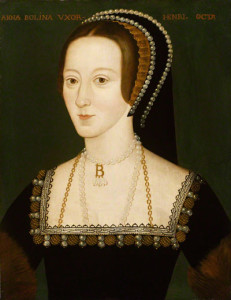Anne’s date of birth is remarkably uncertain, somewhere between 1501 and 1507. Her father, Thomas Boleyn, had been a peripatetic diplomat for both Henrys VII and VIII, was a linguist, and Anne followed in his footsteps. As a young girl she was a maid of honour to the Archduchess of Austria (in Holland) and later to the Queen of France; she was well thought of, and fluent in that language. Interestingly, although the Bible was banned from translation into English, Anne had one in French and was a devout follower of a humanist tradition. In 1522 she returned to England where she became well known in court circles having at her disposal all the charms and skills of the Austrian and French court training.

Henry had already bedded her sister Mary, it was reputed he was far from the first to do so, but by all accounts Anne refused to follow her older sister’s bad example. Possibly her refusal, the “hard to get” line stirred Henry, but he seems to have lost his head over Anne. He proposed marriage to her while still married to Catherine, he brought her home with him, to live in Greenwich Palace while Catherine was also there. Possibly they expected the annulment to take less time than it did, but in January 1533 they married in secret, four months later Cranmer, Archbishop of Canterbury, declared Henry’s marriage to Catherine to be void and his marriage to Anne to be valid; in June she was crowned Queen, and in September Elizabeth (later Queen Elizabeth) was born. (Twenty three years later, when Catherine’s daughter came to the throne, Cranmer was burnt at the stake in 1556.)
Henry was certainly besotted with the sweet demure Anne. In Hampton Court, what is now known as Anne Boleyn’s Gateway stands between the Base and Clock Courts. Although Wolsey’s arms are still clearly recognisable over the arch of the entranceway, it is designated in her name since she was the Queen at the time it was embellished by Henry. When Henry was working on the replanning and rebuilding of the Royal Apartments in Hampton Court, whereas Catherine’s had been above his in the design that Wolsey had made, Henry brought Queen Anne’s apartment down to the same level as his own. Although today it might be considered vulgar, she had mirrors attached to her apartment ceilings.
On her sweet and demure side, Anne was devout, read the Bible in French and English translations, reproved those who swore, was generous to the poor as Catherine had been, but also loved music and dancing. On the less demure side of her character, she became the “go-to” person for those who wanted favours from Henry, and early on, even before her marriage, it was recognised more was to be obtained through her than through Wolsey. On the “not perceptive” side she failed to understand that men do not like women who beat them in argument, Catherine reared differently knew this and persuaded Henry by her grace not her tongue. Anne declared, the King should not dispute with his wife since she always won – she wasn’t smart enough torealize,“he who commands the axeman has the last laugh.” It was reported she never dined with Henry without there being some argument on Scripture which was thoroughly debated. It was noted that King Henry ordered his subsequent wives to avoid argument.
Henry continued to seek his pleasures outside marriage, but it has been said in his defence he was the only king who had more wives than mistresses, of the latter Bessie Blount, Mary Boleyn and Madge Shelton were named – the ambassador of the Holy Roman Empire, a Savoyard named Eustace Chapuys, delighted in reporting them. Among those who caught Henry’s eye was Jane Seymour, an attendant on Anne, as Anne had been on Catherine for four years before Henry noticed her. Jane came from Wolf Hall in Wiltshire where Henry with his entourage had passed a week. It might have been smart if Anne had tolerated this, as had Catherine, instead of openly raging at Henry and dismissing from court the girls he eyed.
Anne was pregnant again in 1534. How this ended is not known, but there was no live child, and it is even suggested the pregnancy was falsely claimed. She was reported pregnant again at the end of 1534. There was also a question of Henry’s ability to perform; he was getting corpulent, had suffered a bladder problem, possibly also had a testicular tumour and Anne had observed to her sister-in-law that Henry in bed lacked both skill and strength.
By 1535, two years after the marriage, the ambassador of Venice reported Henry was tired of it all, and Chapuys reported Henry dare not contradict her. But in October of 1535 she was pregnant again, only to have a stillborn son in January, of less than viable age. Henry seems to have given up on Anne at this point, and was already involved with the one who would be wife number three. Thomas Cromwell obliged his master, accumulated a bevy of persons accused of adultery and incest with Anne who was taken to the dreaded Tower in May of 1536, probably no one believed the charges, but what did that matter? Cranmer obliged the King once more by stating his marriage to Anne was also invalid, and on May 19th Anne and her head parted company.
